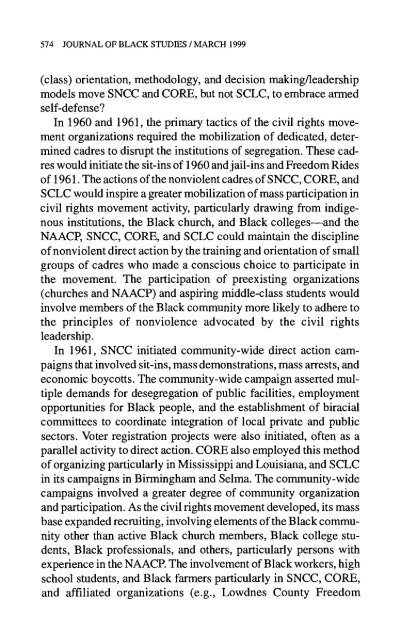MXGM Self-Defence Manual
MXGM Self-Defence Manual
MXGM Self-Defence Manual
Create successful ePaper yourself
Turn your PDF publications into a flip-book with our unique Google optimized e-Paper software.
574 JOURNAL OF BLACK STUDIES / MARCH 1999<br />
(class) orientation, methodology, and decision making/leadership<br />
models move SNCC and CORE, but not SCLC, to embrace armed<br />
self-defense<br />
In 1960 and 1961, the primary tactics of the civil rights movement<br />
organizations required the mobilization of dedicated, determined<br />
cadres to disrupt the institutions of segregation. These cadres<br />
would initiate the sit-ins of 1960 and jail-ins and Freedom Rides<br />
of 1961. The actions of the nonviolent cadres of SNCC, CORE, and<br />
SCLC would inspire a greater mobilization of mass participation in<br />
civil rights movement activity, particularly drawing from indigenous<br />
institutions, the Black church, and Black colleges-and the<br />
NAACP, SNCC, CORE, and SCLC could maintain the discipline<br />
of nonviolent direct action by the training and orientation of small<br />
groups of cadres who made a conscious choice to participate in<br />
the movement. The participation of preexisting organizations<br />
(churches and NAACP) and aspiring middle-class students would<br />
involve members of the Black community more likely to adhere to<br />
the principles of nonviolence advocated by the civil rights<br />
leadership.<br />
In 1961, SNCC initiated community-wide direct action campaigns<br />
that involved sit-ins, mass demonstrations, mass arrests, and<br />
economic boycotts. The community-wide campaign asserted multiple<br />
demands for desegregation of public facilities, employment<br />
opportunities for Black people, and the establishment of biracial<br />
committees to coordinate integration of local private and public<br />
sectors. Voter registration projects were also initiated, often as a<br />
parallel activity to direct action. CORE also employed this method<br />
of organizing particularly in Mississippi and Louisiana, and SCLC<br />
in its campaigns in Birmingham and Selma. The community-wide<br />
campaigns involved a greater degree of community organization<br />
and participation. As the civil rights movement developed, its mass<br />
base expanded recruiting, involving elements of the Black community<br />
other than active Black church members, Black college students,<br />
Black professionals, and others, particularly persons with<br />
experience in the NAACP. The involvement of Black workers, high<br />
school students, and Black farmers particularly in SNCC, CORE,<br />
and affiliated organizations (e.g., Lowdnes County Freedom


